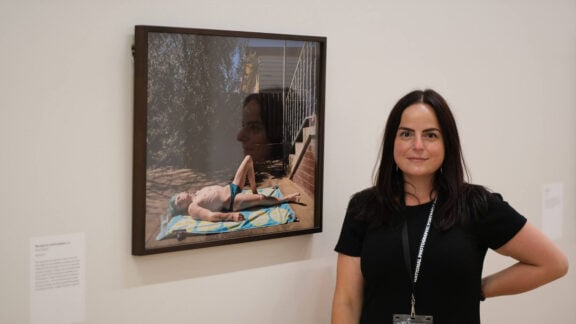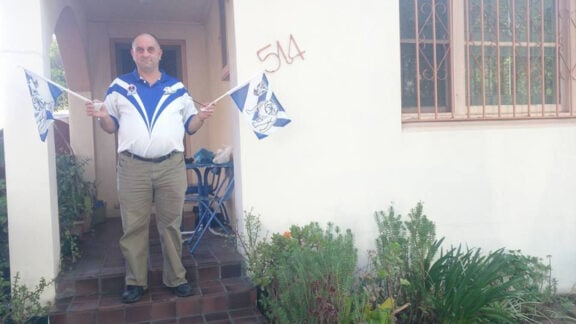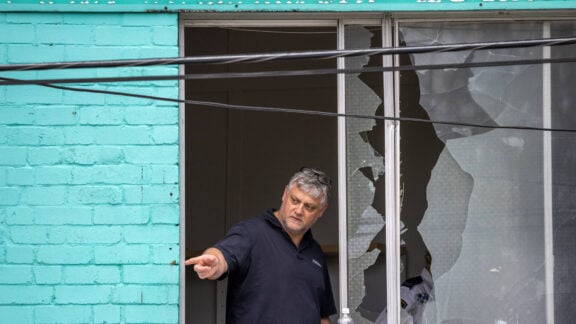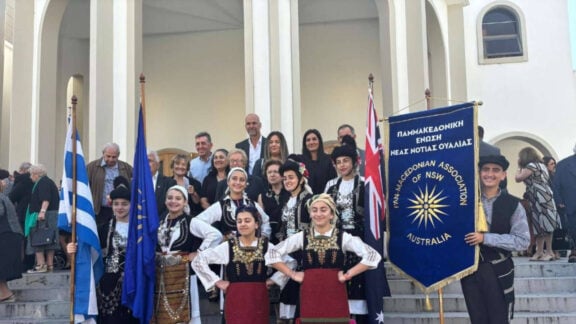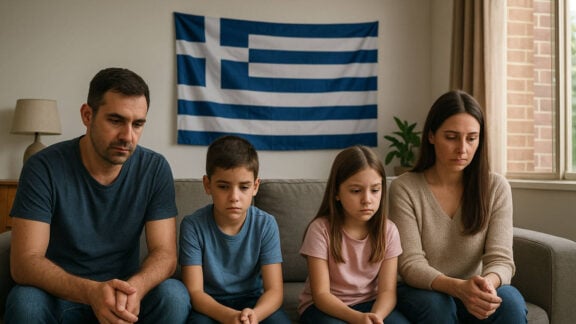The walls of Athens’ buildings are travelling to Canberra, in order to narrate the story of the city and its people as it has unfolded in these past six years of severe austerity. No, this is not a case of demolition and transport of actual walls of bricks and concrete; it is photographs of said walls that will appear, as part of the ‘Murals of Athens’ exhibition opening on Wednesday 2 December at the ambassador’s residence, featuring 23 pictures of Athens’ street art. These modern murals describe, in a unique way, how the ongoing financial crisis and the imposition of the austerity memorandum have affected life in Athens, forcing the economy to collapse, the social fabric to become torn, the society as a whole to asphyxiate.
The exhibition also serves as a farewell from the ambassadorial couple, as Haris Dafaranos ends his run as Greece’s ambassador to Australia. His wife Eva Dafaranos is the curator of the art show; in the exhibition’s brochure she describes the featured artworks as “a testament of how artistic creativity can deliver in difficult times. A generalised expression of disappointment, triggered by the pitiless austerity measures for six years now, has evolved into a peaceful creative artistic movement which reclaims space and transmits a permanent and vivacious series of social messages, together with slogans, wall paintings and graffiti”.
“Serving, in a certain degree, the political and economical establishment, does not deprive you of the constitutional and human right to critical thinking”, Mrs. Eva Dafaranos says, stating the importance of “telling things as they are and judging the errors of political choices, as seen through the values of humanism and national dignity”.

Talking to Neos Kosmos, Mrs Dafaranos described the process and thinking behind this original art show. “I thought that a photo exhibition, depicting the collective feeling of the citizens of a metropolis, in the midst of an financial crisis of unprecedented harshness and psychological pressure, through street art would be unique, in terms of artistic aesthetics, transferring intense messages,” she says, hoping that the exhibition will make the viewer feel sympathy and solidarity to the people of Greece.
Among the works displayed is Pavlos Tsakonas’ solemn Praying Hands, based on Albrecht Durer’s homonymous drawing that caused great sensation when it was unveiled in 2011, on the wall of ‘Vienna’ Hotel at Peiraios Street, as well as Antonis Fikos’ Wasted Love series of street art, featuring sad angels, drawn in a technique that brings to mind Byzantine iconography. Mrs Dafaranos singles out these works, along with the tribute to ‘Loukanikos’, the legendary stray dog that followed protesters during the anti-austerity demonstrations and clashes with the police.
One would argue that this theme – a symbol of anti-establishment riot – would not normally be associated with someone who is part of the upper levels of politics.
“Serving, in a certain degree, the political and economical establishment does not deprive you of the constitutional and human right to critical thinking,” she objects, stating the importance of “telling things as they are and judging the errors of political choices, as seen through the values of humanism and national dignity”.

Mrs Dafaranos remembers first seeing these works as she drove past them, travelling through the city.
“It is hard to me to imagine the public space of Athens, tomorrow, without these examples of street art,” she says. “It has become part of the city’s culture, reflecting the Athenian psyche.”
According to her, crisis-ridden Athens is a city in pain, even if the better-off north and south suburbs are standing still and fail to understand the problems of 1.5 million unemployed.
There are two sides of Athens, she says. “On the one hand, there is the one where human pain prevails, where one-third of the population has become poor, the Athens of soup kitchens and mobile clinics, where social outcasts are looking for food in the trash. And on the other hand there is a strong emergence of social solidarity.”
This is also reflected to the works featured in the exhibition.

As she states in the brochure: “It is not the art of loss of hope.”
When asked why she chose this way to bid farewell to Australia, Mrs Dafaranos answers that there is no better way “to evoke strong feelings of philhellenic sympathy to modern Greece than this original and direct kaleidoscope”.
As for an exhibition that would feature her own experience in Australia, it would have as its theme “the melancholy caused by the Antipodes, as the edge of Earth, down and under. And also, the need to have a cultural ‘backpack’ in order to stand; this would be the Greek soul and culture – films, music, food, a glass of ouzo, a group of friends, communication via phone or internet. Third, it would be about the decision to stay here for the rest of your life, the migrant factor; the ‘alone, but not lonely’ approach; setting down roots, establishing relationships, the blossom of a family, the great respect to the older generation of titans and my great respect for the new generation. Finally, the Australian touch. The beautiful nature, the landscapes, animals and flowers. All this would be on the canvas, or in a short film”.


